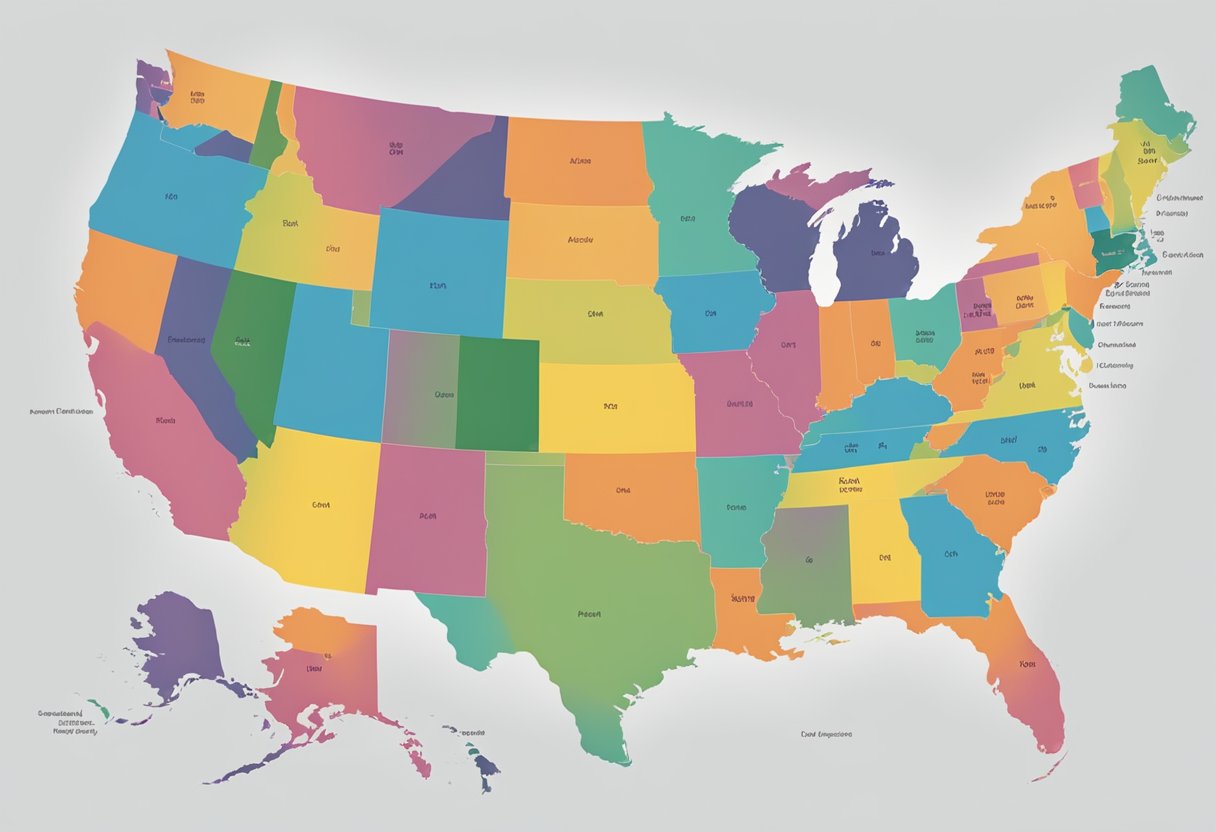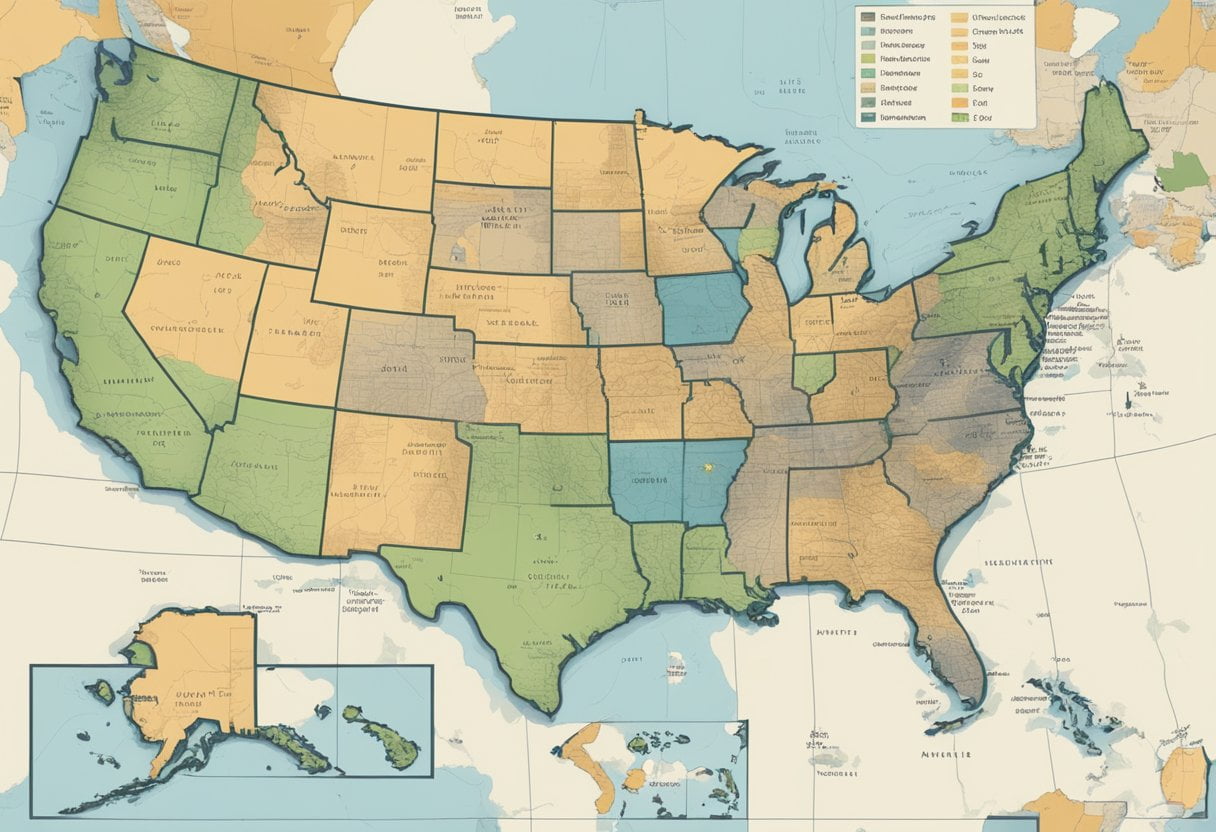What Are The Top States to Buy Multi-Family Properties in 2024: Investor’s Guide to Maximizing Returns
Top States to Buy Multi-Family Properties in 2024: Investor’s Guide to Maximizing Returns
Investing in multifamily properties is a strategic move in 2024 as market dynamics shift and demand for housing continues to grow. As an investor, you recognize the value in multifamily real estate, which offers the potential for stable cash flow, scalability in your portfolio, and significant tax advantages. States with strong economic growth, job opportunities, and population influx stand out as prime locations. Your understanding of market signals and asset performance is key when selecting the right state to invest in, ensuring that your financial objectives align with location demographics and real estate trends.

Navigating the complexities of the multifamily market requires a clear grasp of the various economic indicators that can impact your investment. Factors such as employment rates, rental demand, and the regulatory environment play substantial roles in the performance of your real estate assets. States that offer a combination of these positive economic indicators present enticing opportunities for purchasing multifamily properties. Furthermore, the integration of technology in property management and the emphasis on essential amenities contribute to the attractiveness and resilience of multifamily investments.
Key Takeaways
- Multifamily properties continue to be strong investment choices in 2024.
- Economic indicators and market dynamics are critical for selecting the best states.
- Integration of technology and amenities enhances multifamily property appeal.
Why Multifamily Properties Are Prime Investments in 2024
As you explore the real estate landscape in 2024, multifamily properties emerge as a highly attractive option for several compelling reasons. Your investment in multifamily real estate can be a strategic move, potentially securing steady returns amidst a dynamic economic backdrop.
Stable Demand: The multifamily sector continues to benefit from a persistent demand. Factors like high mortgage rates and tight housing inventories constrain the single-family market, making rentals an appealing choice for many. The resulting stability in occupancies can promote reliable cash flows for you, the investor.
Economic Resilience: Even in periods of economic fluctuation, the need for housing persists. Multifamily units, offering varying price points and locations, often retain their desirability. Your investment in these properties could display resilience, even in tougher economic times.
| Advantages for Investors | Details |
|---|---|
| Diverse Income Streams | A single multifamily property generates multiple rent payments, diversifying income. |
| Scalability of Investments | Investing in one multifamily property can be more efficient than managing multiple single units. |
| Attractive Financing Options | Lenders often favor multifamily real estate, potentially offering advantageous loan terms. |
Moreover, with a keen eye on the best markets to invest in, such as those with strong employment growth and population trends, you can align your investment with areas that show promising rent growth and low vacancy rates. Your careful selection of multifamily real estate in these markets can greatly enhance the potential for favorable returns.
In sum, multifamily properties in 2024 offer you both a cushion against market volatility and an avenue for continued growth in the real estate investment sector. This asset class commands attention for its diversified income potential and inherent demand, making it a key addition to your investment portfolio.
Assessing the Economic Indicators Affecting Multifamily Investments

As you consider multifamily investments in 2024, key economic indicators such as interest and mortgage rates, alongside job market and population growth, play pivotal roles in determining the vitality of your investment.
Interest Rates and Mortgage Trends
In 2024, interest rates impact your mortgage costs significantly. If the Federal Reserve opts to reduce rates, your potential for lower financing costs could improve. It’s essential to monitor these trends as they directly influence your return on investment. For mortgage rates, a downward trend this year can mean more purchasing power for you, leading to potentially higher cash flows from multifamily properties.
Job Market and Population Growth
The job market is intrinsically tied to the performance of multifamily investments. In states with a stable or growing job market, demand for housing typically increases, driving rent upwards. Monitor areas with robust GDP growth, since a strong economy often translates into job creation. Population growth is another crucial metric; a rising population in a given state usually necessitates more housing, benefiting multifamily property demand. When assessing states for investment in 2024, prioritize those with positive job market trends and demonstrable population growth.
Evaluating What Are the Top States To Buy Multi-family Properties in 2024

When you’re considering where to invest in multifamily properties in 2024, the key factors you need to focus on are the growth prospects of emerging markets and the stability offered by established ones.
Growth Markets to Watch
Atlanta, Georgia: With a bustling economy and substantial job growth, Atlanta stands out as a prime market. Look for opportunities in both the city and its expanding metro area.
- Population Growth: Consistently high, driven by diverse employment opportunities.
- Average Rental Yield: Attractive, thanks to a growing renter population.
Raleigh/Durham, North Carolina: Known for its research hub and educational institutions, the Raleigh/Durham area offers a stable tenant base with steady growth.
- Economic Drivers: Technology, education, and a business-friendly environment.
- Housing Demand: Amplified by an influx of professionals and graduates.
Phoenix, Arizona: Phoenix is witnessing a population surge, thanks to its warm climate and favorable business conditions.
- Job Market: Robust, with new enterprises setting up regularly.
- Rental Market: Hot, with an increasing number of people looking for long-term rental solutions.
Texas: Across Texas, cities like Austin and Houston are experiencing growth due to a no state income tax policy, luring businesses and individuals alike.
- Investment Perks: High cap rates in certain areas, and a pro-business stance.
- Housing Trends: Demand exceeding supply in key economic centers.
Established Markets for Stability
Charlotte, North Carolina: Charlotte’s multifamily market is propelled by finance and tech industries, providing a solid foundation for multifamily investments.
- Economic Foundations: Strong financial sector with a burgeoning tech scene.
- Real Estate Market: Competitive, offering long-term growth potential.
Las Vegas, Nevada: Despite its reputation for tourism, Las Vegas offers a stable multifamily market with a growing local economy.
- Diverse Economy: It’s expanding beyond entertainment to include healthcare and technology.
- Affordability: More affordable when compared to coastal metros, attracting long-term residents.
Remember, your investment strategy should align with your financial goals, whether you’re looking for rapid appreciation in emerging markets or steady cash flow from established ones.
Understanding Multifamily Market Dynamics

In assessing the best states to buy multifamily properties in 2024, it’s crucial to comprehend market dynamics, which hinge on demand and supply, as well as rental market trends that significantly influence the multifamily sector.
Demand and Supply Factors
Understanding the demand from renters for multifamily units is vital. High demand often correlates with regions experiencing significant population growth or a surge in employment, particularly in sectors such as technology. Supply refers to the availability of multifamily units in the market. An imbalance, where demand outstrips supply, may lead to increased rent growth and lower vacancy rates, a boon for investors. Conversely, ample or excess supply can lead to higher vacancy rates and slower rent growth.
For instance, markets like Tampa, Florida, have seen population increases, suggesting a high demand for rental accommodations. Simultaneously, certain markets may also experience a tendency towards longer-term rentals, influenced by factors such as high mortgage rates and a broader push towards affordable housing options, which sustains demand in the multifamily sector.
Rental Market Insights
When evaluating the rental market, you should analyze key metrics that provide insights into its health. These include rental growth rates, which indicate the potential for rental income to rise, and occupancy rates, which reflect the percentage of units rented out. For example, a city with rent growth projections, like Austin, Texas, signals a flourishing market for investors.
Additionally, consider the shift towards long-term rental preferences over homeownership. This shift, sparked by high mortgage rates and housing market unaffordability, could strengthen the multifamily sector as more people opt to rent. Remember, markets offering a combination of job growth, favorable business environments, and no state income tax, such as certain cities in Texas and Florida, are likely to bolster demand for multifamily investments in 2024.
Analyzing Financial Aspects of Multifamily Investing

When considering the purchase of multifamily properties as an investment in 2024, understanding the financial intricacies is crucial. Key performance indicators, such as cap rates and return on investment, along with knowledge of financing options and strategies, will guide you in making an informed decision.
Cap Rates and Returns on Investment
Cap rate—which stands for capitalization rate—is a fundamental metric in assessing the profitability of a multifamily property. It is calculated by dividing the net operating income (NOI) by the property value. In simpler terms:
- Cap Rate = NOI / Property Value
A higher cap rate typically indicates a potentially higher return on your investment, but it might also come with increased risk. When buying a multifamily property, look for areas where cap rates are substantial, but take into account the potential for appreciation and the general stability of the market.
The return on investment (ROI) gives you a broad sense of the profitability of an investment over time. To calculate the ROI when it comes to real estate, consider all costs, including purchase price, renovation expenses, and operational costs, against the total income and gains from the property when you decide to sell. Keep in mind that holding a property can sometimes offer better returns as it accrues value and generates continuous rental income.
Financing Options and Strategies
Various financing options are available when investing in multifamily real estate. You might go for traditional mortgages through banks or credit unions, which usually require a down payment of around 20-30%. Other financing methods include:
- Government-Backed Loans: Such as those offered by the FHA, which may offer lower down payments.
- Private Lenders: Typically provide quicker funding but at higher interest rates.
- Owner Financing: Where the seller agrees to finance the purchase, often leading to more flexible terms.
Your financing strategy should align with your investment goals. If you aim to hold a property for rental income, securing long-term, fixed-rate financing might be optimal to ensure stability in cash flow. Conversely, if you intend to renovate and sell the property, short-term financing options like a bridge loan may be more suitable. Before committing to any loan, ensure you understand the terms, rates, and any prepayment penalties that may affect your investment strategy.
Identifying Key Amenities and Services for Multifamily Properties
When looking to invest in multifamily properties, the amenities and services offered can be pivotal factors that influence renters’ decisions and, in turn, impact rents and property values.
What Renters Want
- Property-Wide Smart Access: Tenants prioritize the convenience and security of smart access systems.
- Video Intercom: A high demand exists for secure, user-friendly video intercoms.
- Secure, Self-Service 24/7 Package Access: Round-the-clock package access is a sought-after amenity, reflecting the ongoing boom in e-commerce.
- Property Dog Park: As pet ownership increases, dog parks within the property are essential for residents.
- Rooftop Space: Outdoor spaces, particularly rooftop areas, are highly desirable for their leisure and entertainment value.
- Fitness Centers: Convenience of on-site fitness facilities is crucial for the increasingly health-conscious renter.
Enhancing Property Value
A direct correlation exists between the quality and range of amenities and the value of a multifamily property within the real estate market. To ensure your property remains competitive:
- Long-term Rentals Appeal: Shift towards offering long-term rentals, in an environment where homeownership is less affordable.
- Service Quality: Ensuring excellent service delivery can result from investing in qualified multifamily professionals. Good service is an intangible amenity that enhances residents’ quality of life.
- Amenity Maintenance: Regularly upgrade and maintain amenities, which can have a significant positive impact on both retention rates and the ability to command higher rents.
By focusing on these amenities and services, you can aim to provide a superior quality of life that tenants are willing to pay a premium for, thereby bolstering your property’s value in the competitive real estate market.
Navigating the Legislative and Regulatory Environment
When considering investment in multi-family properties in 2024, understanding the intricate legislative and regulatory landscape is crucial. These elements can significantly impact the viability and profitability of your investment.
Zoning and Construction Regulations
You’ll find that zoning laws can either be a hurdle or a catalyst for your project. Zoning determines land use and restricts or allows certain types of development, which affects where you can construct multi-family properties. Stay updated on local policies as they can change to either relax regulations, which could be a result of COVID-19’s impact on housing demand, or to tighten them in response to community pushback.
For construction regulations, be aware that legislation at both the state and federal level can affect material costs, project timelines, and labor. Infrastructure initiatives may facilitate access to better utilities and roads, fostering a desirable location for multi-family properties.
Affordable Housing Initiatives
Affordable housing has become a central focus in numerous states, particularly with the post-COVID-19 emphasis on economic recovery. You may want to closely follow affordable housing legislation, as it often includes incentives such as tax credits for developers who allocate a percentage of units to low-income residents.
States may also implement specific affordable housing programs that align with federal initiatives. This could range from funding for new construction to subsidies for renovation of existing structures. A strategic approach to these initiatives can strengthen the community and enhance the desirability of your multi-family investment.
Leveraging Technology in Multifamily Real Estate
In the multifamily real estate market, technology serves as both a facilitator and a game-changer. By leveraging AI, big data, and tech-driven management tools, you can gain a competitive edge in real estate transactions and the day-to-day management of multifamily housing.
AI and Big Data in Market Analysis
Artificial Intelligence (AI) and big data are revolutionizing how you analyze the real estate market. Tools that harness these technologies can process vast amounts of market data-points to uncover trends and forecasts that might not be visible to the human eye. For example:
- AI algorithms can predict area population growth, helping you pinpoint emerging markets with a potentially higher demand for multifamily housing.
- Big data analytics enable you to assess investment risks more accurately by analyzing factors like local unemployment rates, rental market trends, and economic forecasts.
Tech-Driven Property Management
Technology is not just enhancing the way you analyze markets; it is also transforming property management:
- Automated tenant screening systems utilize AI to quickly process applications, reducing the time your properties sit vacant.
- Online tenant portals streamline rent payments and maintenance requests, improving tenant satisfaction and operational efficiency.
- Smart home technology integrated into multifamily units can attract tech-savvy tenants and command higher rents.
By embracing these technology-driven strategies, you are well-equipped to thrive in the dynamic landscape of multifamily real estate.
Frequently Asked Questions
In 2024, understanding the landscape of multi-family property investments is key to making informed decisions that align with your financial goals. Here are concise and clear answers to some of the commonly asked questions.
Which states offer the highest return on investment for multi-family properties in 2024?
Your best returns might come from states like Florida, specifically Tampa, which has seen a significant population increase, promising sustained rental demand and the potential for strong ROI.
Which states provide the most favorable conditions for buying multi-family rentals this year?
Look towards states that have a strong influx of population, low property taxes, and favorable landlord-tenant laws. States such as Texas and North Carolina have demonstrated favorable conditions for multi-family rentals due to economic growth and regulatory environments.
What are the emerging markets for multi-family real estate investments in 2024?
Emerging markets, especially in the Sun Belt region due to its growing population and employment opportunities, are worth your attention. Markets like Salt Lake City, Utah, and Charlotte, North Carolina are becoming popular for multi-family investments.
Where can investors find the highest concentration of multi-family homes for potential investment?
Investors will find higher concentrations of multi-family homes in metropolitan areas experiencing urbanization and growth. Cities in Florida, Texas, and California often have a large inventory of multi-family units.
What are the advantages of investing in rental properties in up-and-coming states?
Investing in up-and-coming states often means lower entry prices and the potential for property appreciation. Rental demand in such markets may be on the rise, offering the opportunity for higher rental incomes as the market matures.
Which states have shown the most significant growth in the rental property sector for investors?
States with significant job growth, like Texas and Florida, have seen considerable growth in their rental property sectors. The affordability crisis in homeownership has also boosted the rental markets in these states.
How can I assess local real estate demand using market research tools?
Local real estate demand can be gauged through a blend of quantitative and qualitative analysis. Start with demographic and economic data from governmental sources to understand the population growth and employment landscape of an area. Use MLS databases to track inventory levels, days on market, and changes in sale prices. Look at rental market statistics to assess investment potential and demand trends. Interviewing local real estate agents and attending community meetings can also provide valuable insights into the vibrancy of the local real estate market.
What is the importance of customization in real estate market research tools?
Customization plays a pivotal role in real estate market research tools because it allows users to tailor the analysis to specific needs and criteria. Users can set parameters that are aligned with their investment strategies, such as focusing on a particular geographic area, property type, or price range. Customization ensures that the data and analysis provided are directly relevant, eliminating unnecessary information and enhancing the efficiency of the research process. This targeted approach results in more accurate assessments and strategic insights for data-driven decision making.
Statistics
- Approximately 90% of real estate companies use an MLS system to support the sale and purchase of properties.
- Tools utilizing GIS technology allow for 80% faster analysis of geographical data within the real estate sector.
External Links
- The U.S. Census Bureau provides an extensive reservoir of demographic and economic data vital for real estate market assessments. Visit the U.S. Census Bureau
- REIS delivers original market research on commercial real estate properties and trends for investors and real estate professionals. Visit REIS
How To
How to Leverage Demographic Data for Property Investment Decisions
Demographic data provides insights into the target audience for property investments. For reliable demographic information, utilize resources such as the U.S. Census Bureau or local government databases. Analyze this data to understand population growth, age distribution, income levels, and household composition in the areas you are considering for investment. Cross-reference this information with property types and price points to ascertain demand and investment viability. Effective use of demographic data can significantly impact the profitability of your real estate investments.





